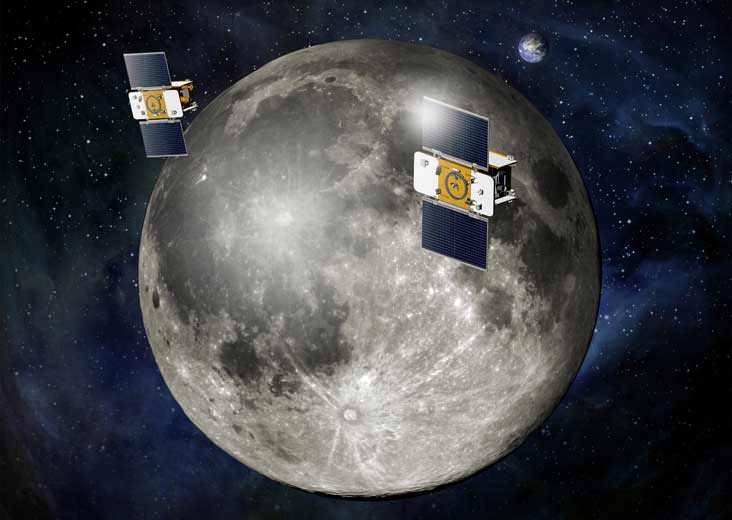[/caption]
Cheers erupted after the first of NASA’s twin $496 Million Moon Mapping probes entered orbit on New Year’s Eve (Dec. 31) upon completion of the 40 minute main engine burn essential for insertion into lunar orbit. The small GRAIL spacecraft will map the lunar interior with unprecedented precision to deduce the Moon’s hidden interior composition.
“Engines stopped. It’s in a great initial orbit!!!! ”
- NASA’s Jim Green told Universe Today, just moments after verification of a successful engine burn and injection of the GRAIL-A spacecraft into an initial eliptical orbit. Green is the Director of Planetary Science at NASA HQ and was stationed inside Mission Control at NASA’s Jet Propulsion Laboratory (JPL) in Pasadena, Ca (see photos below).
“Pop the bubbly & toast the moon! NASA’s GRAIL-A spacecraft is in lunar orbit,” NASA tweeted shortly after verifying the critical firing was done. “Burn complete! GRAIL-A is now orbiting the moon and awaiting the arrival of its twin GRAIL-B on New Year’s Day.”
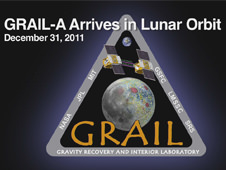
The firing of the hydrazine fueled thruster was concluded at 5 PM EST (2 PM PST) today, Dec. 31, 2011 and was the capstone to a stupendous year for science at NASA.
“2011 was definitely the best year ever for NASA Planetary Science,” Green told me today. “2011 was the “Year of the Solar System”.
“GRAIL-A is in a highly elliptical polar orbit that takes about 11.5 hours to complete.”
“We see about the first eight to ten minutes of the start of the burn as it heads towards the Moon’s southern hemisphere, continues as GRAIL goes behind the moon and the burn ends about eight minutes or so after it exits and reappears over the north polar region.”
“So we watch the beginning of the burn and the end of the burn via the Deep Space Network (DSN). The same thing will be repeated about 25 hours later with GRAIL-B on New Year’s Day [Jan 1, 2012],” Green explained.
The orbit is approximately 56-miles (90-kilometers) by 5,197-miles (8,363-kilometers around the moon. The probe barreled towards the moon at 4400 MPH and skimmed to within about 68 miles over the South Pole.
“My resolution for the new year is to unlock lunar mysteries and understand how the moon, Earth and other rocky planets evolved,” said Maria Zuber, GRAIL principal investigator at the Massachusetts Institute of Technology in Cambridge. “Now, with GRAIL-A successfully placed in orbit around the moon, we are one step closer to achieving that goal.”
Zuber witnessed the events in Mission Control along with JPL Director Charles Elachi (see photos).

The mirror twin, known as GRAIL-B, was less than 30,000 miles (48,000 km) from the moon as GRAIL A achieved orbit and closing at a rate of 896 mph (1,442 kph). GRAIL-B’s insertion burn is slated to begin on New Year’s Day at 2:05 p.m. PST (5:05 p.m. EST) and will last about 39 minutes.
GRAIL-B is about 25 hours behind GRAIL-A, allowing the teams enough time to rest and prepare, said David Lehman, GRAIL project manager at JPL.
“With GRAIL-A in lunar orbit we are halfway home,” said Lehman. “Tomorrow may be New Year’s everywhere else, but it’s another work day around the moon and here at JPL for the GRAIL team.”
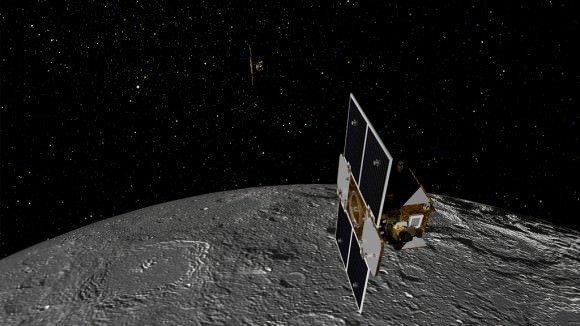
Engineers will then gradually lower the tandem flying satellites into a near-polar near-circular orbital altitude of about 34 miles (55 kilometers) with an average separation of about 200 km. The 82 day science phase will begin in March 2012.
“GRAIL will globally map the moon’s gravity field to high precision to deduce information about the interior structure, density and composition of the lunar interior. We’ll evaluate whether there even is a solid or liquid core or a mixture and advance the understanding of the thermal evolution of the moon and the solar system,” explained GRAIL co-investigator Sami Asmar to Universe Today. Asmar is from JPL.
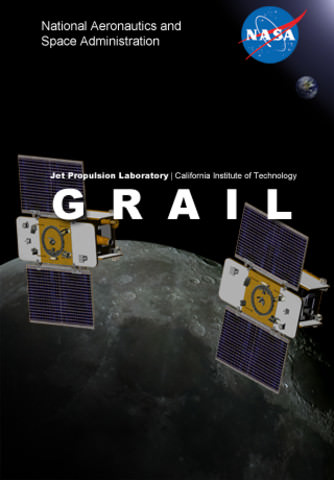
New names for the dynamic duo may be announced on New Year’s Day. Zuber said that the winning names of a student essay contest drew more than 1000 entries.
The GRAIL team is making a major public outreach effort to involve school kids in the mission and inspire them to study science. Each spacecraft carries 4 MoonKAM cameras. Middle school students will help select the targets.
“Over 2100 Middle schools have already signed up to participate in the MoonKAM project,” Zuber told reporters.
“We’ve had a great response to the MoonKAM project and we’re still accepting applications.”
MoonKAM is sponsored by Dr. Sally Ride, America’s first female astronaut. The first images are expected after the science mission begins in March 2012.
The GRAIL twins blasted off from Florida on September 10, 2011 for a 3.5 month low energy path to the moon so a smaller booster rocket could be used to cut costs.
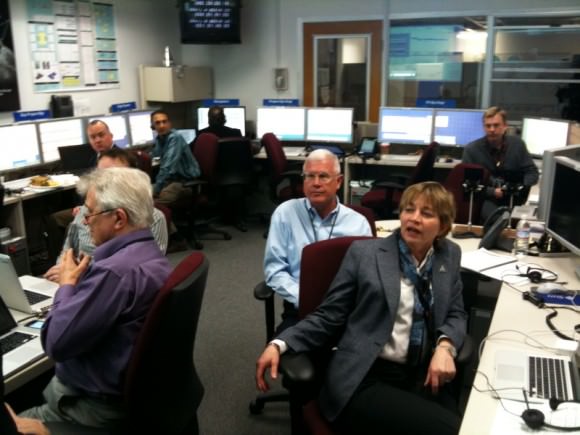
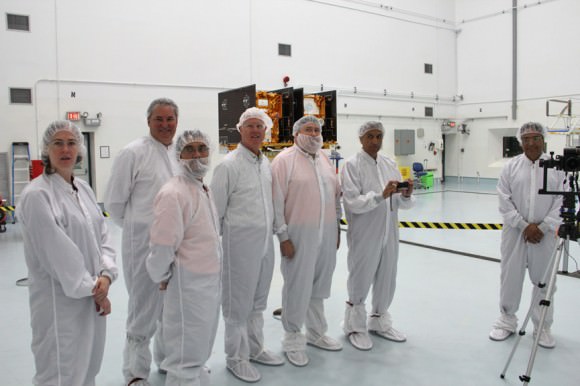
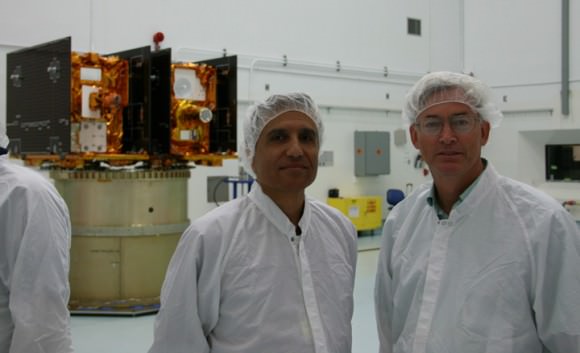
GRAIL Co-Investigator Sami Asmar (left) from JPL and Ken Kremer discuss science objectives inside Astrotech clean room prior to encapsulation for launch. Credit: Ken Kremer
Read continuing features about GRAIL by Ken Kremer here:
2011: Top Stories from the Best Year Ever for NASA Planetary Science!
NASA’s Unprecedented Science Twins are GO to Orbit our Moon on New Year’s Eve
Student Alert: GRAIL Naming Contest – Essay Deadline November 11
GRAIL Lunar Blastoff Gallery
GRAIL Twins Awesome Launch Videos – A Journey to the Center of the Moon
NASA launches Twin Lunar Probes to Unravel Moons Core
GRAIL Unveiled for Lunar Science Trek — Launch Reset to Sept. 10
Last Delta II Rocket to Launch Extraordinary Journey to the Center of the Moon on Sept. 8
NASAs Lunar Mapping Duo Encapsulated and Ready for Sept. 8 Liftoff
GRAIL Lunar Twins Mated to Delta Rocket at Launch Pad
GRAIL Twins ready for NASA Science Expedition to the Moon: Photo Gallery

